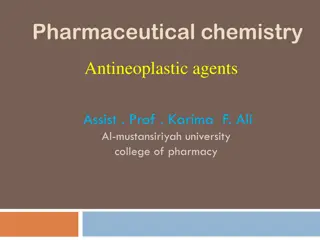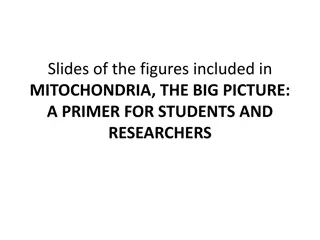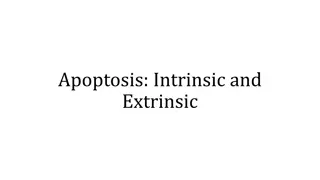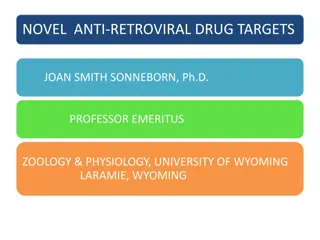
Understanding Apoptosis Process
Discover the intricate process of programmed cell death known as apoptosis. Learn about the biochemical events and characteristic changes that occur during apoptosis, as well as the history and different types of cell death. Dive into the pathways and activation of caspases involved in this essential biological mechanism.
Uploaded on | 0 Views
Download Presentation

Please find below an Image/Link to download the presentation.
The content on the website is provided AS IS for your information and personal use only. It may not be sold, licensed, or shared on other websites without obtaining consent from the author. If you encounter any issues during the download, it is possible that the publisher has removed the file from their server.
You are allowed to download the files provided on this website for personal or commercial use, subject to the condition that they are used lawfully. All files are the property of their respective owners.
The content on the website is provided AS IS for your information and personal use only. It may not be sold, licensed, or shared on other websites without obtaining consent from the author.
E N D
Presentation Transcript
SABINDRA KUMAR SAMAL FOR M.Sc 1ST SEMESTER CLASS P.G. DEPARTMENT OF ZOOLOGY, B.J.B AUTONOMOUS COLLEGE, BBSR
INTRODUCTION o Apoptosis is the process of programmed cell death. o Biochemical events lead to characteristic cell changes (morphology) and death. These changes include blebbing, cell shrinkage, nuclear fragmentation, chromatin condensation, and chromosomal DNAfragmentation. o Between 50 and 70 billion cells die each day due to apoptosis in the average human adult. For an average child between the ages of 8 and 14, approximately 20 billion to 30 billion cells die a day.
HISTORY o German scientist Carl Vogt was first to describe the principle of apoptosis in 1842. o In 1972 Kerr first introduced the term apoptosis in a publication. o Kerr received the Paul Ehrlich and Ludwig Darmstaedter Prize on March 14, 2000, for his description of apoptosis. o The 2002 Nobel Prize in Medicine was awarded to Sydney Brenner, Horvitz and John E. Sulston for their work identifying genes that control apoptosis.
TYPES OF CELL DEATH In multicellular organisms, cell death is a critical and active process that maintains tissue homeostasis and eliminates potentially harmful cells. There are three major types of morphologically distinct cell death: Type I Cell death (Apoptosis) Type II Cell death (Autophagy) Type III Cell death (Necrosis)
APOPTOSIS: PATHWAYS "Extrinsic Pathway" Death Ligands Initiator Caspase 8 Death Receptors CELL DEATH Effector Caspase 3 "Intrinsic Pathway" Initiator Caspase 9 DNA damage & p53 Mitochondria/ Cytochrome C
CASPASE ACTIVATION Caspases are cysteine proteases with specificity for aspartic acid residues in their substrates
Caspase Activation The caspase protein family: Initiator caspases (caspase-2, caspase-8, and caspase-9) are the apical caspases of the apoptotic-signaling cascade. Initiator caspases are produced as inactive zymogens composed of a prodomain (containing a CARD or a death effector domain [DED]) and a large and small subunit. They are recruited through their prodomains into large activation platforms and activated by dimerization. In contrast, executioner caspases (caspase-3, caspase-6, and caspase-7) are activated by cleavage of the zymogen between the large and small subunits and are therefore dependent on initiator caspases for their activation. Catalytically active caspases are composed of a heterotetramer of two small and two large subunits.
Caspase 9 activation (intrinsic pathway) The mitochondrial apoptotic pathway. In response to various cellular stresses, proapoptotic members of the Bcl2 family induce mitochondrial outer membrane permeabilization (MOMP), allowing the release into the cytosol of proapoptotic factors that are normally sequestered in the intermembrane space of the mitochondria (including cytochrome c, Smac, and Omi). In the cytosol, cytochrome c binds to APAF1 and triggers its oligomerization. Caspase-9 is then recruited and activated by this platform, known as the apoptosome. Catalytically active caspase-9 cleaves and activates the executioner caspases-3 and -7. Upon release in the cytosol, Smac and Omi bind to and inhibit the caspase inhibitor X-linked inhibitor of apoptosis (XIAP). In doing so, they relieve XIAP inhibition of caspase-9, caspase-3, and caspase-7, and potentiate overall caspase activation by the apoptosome.
o The intrinsic signaling pathway for programmed cell death involves non-receptor- mediated intracellular signals, inducing activities in the mitochondria that initiate apoptosis. o Stimuli for the intrinsic pathway include viral infections or damage to the cell by toxins, free radicals, or radiation. Damage to the cellular DNA can also induce the activation of the intrinsic pathway for programmed cell death. o Pro-apoptotic proteins activate caspases that mediate the destruction of the cell through many pathways. These proteins also translocate into the cellular nucleus, inducing DNA fragmentation, a hallmark of apoptosis
o The regulation of pro-apoptotic events in the mitochondria occurs through activity of members of the Bcl-2 family of proteins and the tumor suppressor protein p53. o Members of the Bcl-2 family of proteins may be pro- or anti-apoptotic. o The anti-apoptotic proteins are Bcl-2, Bcl-x, Bcl-xL, Bcl-X5 , Bcl- w, and BAG. o Pro-apoptotic proteins include Bcl-10, Bax, Bak, Bid, Bad, Sim, Bik, and Blk.
EXTRINSIC PATHWAY Caspase- 8 Activation: The Death Receptor Pathway
EXTRINSIC PATHWAY Caspase- 8 Activation: The Death Receptor Pathway Apoptosis is induced by this pathway through a mediated interaction of death ligands with death receptors. Accumulating evidence suggest that these death receptors are members of tumor necrosis factor (TNF) which includes the TNF, Fas ligands (Fas-l) and TNF -related apoptosis inducing ligand (TRAIL) In the process, the death receptors (Fas receptor, TNF receptors) bind to death ligands (Fas ligands, TNF ligands) to allows the binding of the death domain / adapter Protein (Fas -associated Death Domain (FADD), TNF receptor associated death domain (TRDD). The binding of the death domain /adapter protein to receptor ligands complex allows the binding of an initiator caspase 8 or 10 through its death effector domain (DED) to form an activated complex called Death inducing signaling complex (DISC). Furthermore, the binding and activation allow the caspase 8 to relay the death signal to an execution caspase to bring about apoptosis
PORFORIN/GRANZYME PATHWAY Perforin/granzyme apoptosis pathway is the primary signaling pathway used by cytotoxic lymphocytes to eliminate virus-infected and/or transformed cells Perforin is a pore-forming protein and also known as cytoplasmic granule toxins. Granzyme is a family of structurally related serine proteases stored within the cytotoxic granules of cytotoxic lymphocytes (CLs). Perforin and granzyme induce target-cell apoptosis cooperatively Both perforin and granzyme bind to the target-cell surface as part of a single macromolecular complex associated with serglycin, which further diminishes the probability of passive diffusion of granzymes Granzyme A (GrA) and granzyme B (GrB) are the most abundant granzymes and have been the most studied
Granzyme B mainly triggers caspase activation indirectly. It achieves this by activating pro-apoptotic BH3-only' members of the BCL-2 family. BH3-interacting domain death agonist (Bid). Bid together with pro-apoptotic BCL-2 family Bax and/or Bak proteins result in the leakage of pro- apoptotic mitochondrial mediators, such as cytochrome c, into the cytosol. Granzyme A induces loss of mitochondrial inner membrane potential and the release of reactive oxygen species (ROS). It generates single-stranded DNA nicks, rather than oligonucleosomal DNA fragments. In response to ROS, the ER-associated SET complex, including SET, Ape1, pp32, HMG2, NM23-H1 and TREX1, translocate to the nucleus, where granzyme A cleaves three members of the SET complex that are involved in DNA repair: HMG2, Ape1, and SET.
3 TYPES OF CASPASES o Inflammatory Caspases : 1, 4 , and 5 o Initiator Caspases: 2, 8, 9, and 10 Long N-terminal domain Interact with effector caspases o Effector Caspases : 3, 6, and 7 Little to no N-terminal domain Initiate cell death
IMPORTANCE OF APOPTOSIS o Important in normal physiology I development - Development: Immune systems maturation, Morphogenesis, Neural development - Adult: Immune privilege, DNA damage and wound repair. o Excess apoptosis - Neurodegenerative diseases o Deficient apoptosis - Cancer - Autoimmunity
APOPTOSIS : important in embrvogenesis Morphogenesis {eliminates excess cells): Selection (eliminates non-functional cells):
Apoptosis is triggered when cell-surface death receptors such as Fas are bound by their ligands (the extrinsic pathway) or when Bcl2-family proapoptotic proteins cause the permeabilization of the mitochondrial outer membrane (the intrinsic pathway). Both pathways converge on the activation of the caspase protease family, which is ultimately responsible for the dismantling of the cell Previous
Autophagy defines a catabolic process in which parts of the cytosol and specific organelles are engulfed by a double-membrane structure, known as the autophagosome, and mostly Autophagy is nevertheless, there are a few examples of autophagic cell death in which components of the autophagic signaling pathway actively promote cell death. eventually a survival degraded. mechanism; Previous
Necrotic cell death is characterized by the rapid loss of plasma membrane integrity. This form of cell death can result from active signaling pathways, the best characterized of which is dependent on the activity of the protein kinase RIP3. Previous
P53 is a tumor suppressor protein, a tetramer with protein size of about 53 kDa thus the name p53. They are involved in cell cycle regulation and development, induction of members of the BCL-2, involved in the mitochondrial outer-membrane permeabilization (MOMP), the mediating of oxidative stress and endoplasmic stress, receptor signaling pathways etc. However, conditions such chemicals, viruses example Human papillomavirus (HPV) infection can render the p53 inactive or reduce it activity thus reducing the intensity of suppression of proliferation. Upon its activation they either enable the cell cycle arrest in the G-phase or an irreparable DNA damage causes them to trigger the activation of some apoptotic inducing proteins such as (Bak, Bcl-10, Bax, Bad, Bid, Bim, Bik, Hrk) and at the same time inhibit anti-apoptotic proteins(Bcl-x, Bcl-w, Bf-1, Bcl-XL, B-XS, Bcl-w, BAG). Additionally, the inability for this process to occur allows tumorigenesis, recent studies have proven that flavonoids were able to induce apoptosis in breast cancer cell through the downregulation of some downstream molecules of p53 (Bcl-2 and Bcl-xl) .Also the alteration of p53 or loss in it activity can downregulate Bax /Noxa /Puma paving way for the upregulation of Bcl-2 thus preventing the MAC formation and also Meng et al suggest that, the negative regulation of p53 by mouse double minute 2 homolog MMD2 is capable of impeding it action.



![textbook$ What Your Heart Needs for the Hard Days 52 Encouraging Truths to Hold On To [R.A.R]](/thumb/9838/textbook-what-your-heart-needs-for-the-hard-days-52-encouraging-truths-to-hold-on-to-r-a-r.jpg)
![[PDF] DOWNLOAD READ Diagnosis Solving the Most Baffling Medical Mysterie](/thumb/9855/pdf-download-read-diagnosis-solving-the-most-baffling-medical-mysterie.jpg)

















